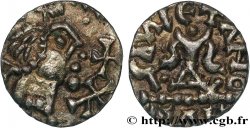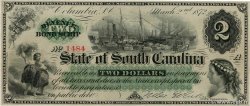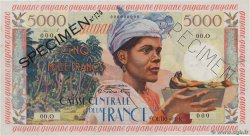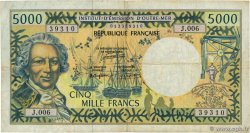bmv_969126 - MEROVINGIAN COINAGE - BANASSAC (BANNACIACO) - Lozere Denier
800.00 €约 6624.00 CNY
数量
加入购物车

种类 Denier
日期: (VIIe-VIIIe siècles)
日期: s.m.
铸币厂名称/城市 Banassac
材质 silver
直径 12 mm
模子方针 3 h.
重量 1,13 g.
稀少度 R3
关于品相的说明
Denier frappé sur un flan irrégulier et un peu court. Hauts reliefs. Patine grise
出版目录中的项代码 :
家谱
Monnaie provenant de la collection Philippe Schiesser
正面
正面的说明书 Calice à deux anses ou mitre stylisée (?), surmonté d’une croixet.
背面
背面的文字 A, K, W, A.
背面的说明书 Croix aux bras bifides, une lettre dans chaque canton.
评论
Le calice, typique du monnayage d’argent de Banassac, est différent sur ce denier par rapport à ceux du Belfort, par exemple. Pour ce type, toutes variétés confondues, G. Depeyot n’a répertorié que neuf exemplaires ; les trois du Belfort, trois de la vente Cahn 1932, deux du trésor de Saint-Pierre-les Etieux et un du trésor de Bais. Un dixième exemplaire est aussi classé à Banassac à cause du calice, mais d’un tout autre type (cf. B. 5757).
Au revers, les lettres A et Z sont relativement nettes dans les 3e et 4e cantons de la croix, mais les lettres dans les deux premiers cantons sont difficiles à identifier. D’après les monnaies n° 774 à 777 du Belfort, il devrait s’agir de RA-G ou LA. Les lettres RAG ont fait attribuer ces deniers à Ragenfrid, mais A. de Belfort les restitue à Banassac en raison des analogies avec les monnaies d’or au calice.
Seulement sur l’exemplaire proposé ici, l’analogie n’est pas du tout évidente et les lettres semblent plutôt être E (rétrograde) au premier canton et D au deuxième canton !
Bien qu’aucune autre monnaie d’argent s’en approchant ne semble être publiée, il est permis de douter de la parenté de ce denier avec les monnaies traditionnellement attribuées à Banassac ?.
Au revers, les lettres A et Z sont relativement nettes dans les 3e et 4e cantons de la croix, mais les lettres dans les deux premiers cantons sont difficiles à identifier. D’après les monnaies n° 774 à 777 du Belfort, il devrait s’agir de RA-G ou LA. Les lettres RAG ont fait attribuer ces deniers à Ragenfrid, mais A. de Belfort les restitue à Banassac en raison des analogies avec les monnaies d’or au calice.
Seulement sur l’exemplaire proposé ici, l’analogie n’est pas du tout évidente et les lettres semblent plutôt être E (rétrograde) au premier canton et D au deuxième canton !
Bien qu’aucune autre monnaie d’argent s’en approchant ne semble être publiée, il est permis de douter de la parenté de ce denier avec les monnaies traditionnellement attribuées à Banassac ?.








 对产品描述纠错
对产品描述纠错 打印
打印 分享我的选择
分享我的选择 提问
提问 Consign / sell
Consign / sell
 产品介绍
产品介绍













